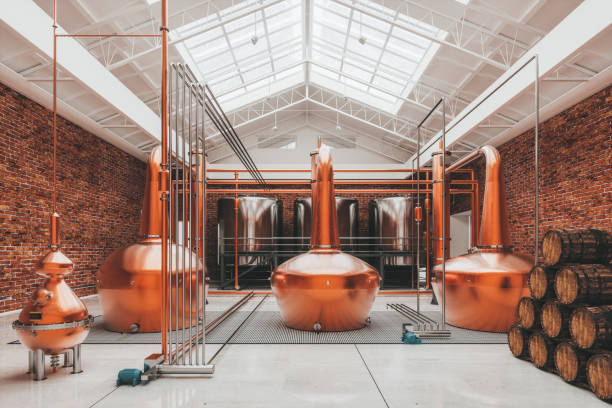
Peat and Smoke: The Impact of Terroir on Whisky Flavor Profiles
- 0
Whisky, often referred to as the “water of life,” is a cherished spirit that has captured the hearts of enthusiasts around the world. Its complex and diverse range of flavours is a result of a delicate interplay between various factors, including the ingredients used in its production, the distillation process, and the ageing environment. One of the most intriguing aspects of whisky flavour development is the influence of terroir, particularly the use of peat and smoke during production, which can dramatically shape the final flavour profile of the spirit.
In this detailed blog post,we look into the world of whisky production, explore the role of peat and smoke, and examine how terroir impacts the flavour profiles, with a special focus on the distinctive case of bourbon.
The Ingredients for Making Whisky
Whisky is often described as a distilled spirit made from fermented grains, water, and yeast. The selection of these ingredients, along with the production process, is critical in defining the unique characteristics of each whisky variety.
Grains: The choice of grains, known as the mash bill, plays a pivotal role in shaping the flavour profile of the whisky. Common grains used include barley, corn, rye, and wheat. Each grain imparts its own flavours, ranging from the sweetness of corn to the spiciness of rye. For instance, a higher proportion of corn in the mash bill is commonly found in bourbon, resulting in a sweeter and smoother profile.
Water: Water is a fundamental ingredient in whisky production. It is used not only for mashing the grains but also for fermentation, dilution, and cooling during distillation. The mineral content and purity of the water influence the final taste of the whisky. The geographical source of water introduces an element of terroir, as the natural minerals present in the water can contribute subtle nuances to the flavour.
Yeast: Yeast is responsible for converting the sugars present in the mash into alcohol through the process of fermentation. Different strains of yeast can produce varying flavours and aromas during fermentation, adding complexity to the whisky’s eventual profile. This is where the magic of transformation begins, as yeast brings together the diverse flavours of the grains and water to create the base spirit.
Distillation and Aging: The distillation process involves heating the fermented mash to separate alcohol from impurities, concentrating the flavours further. The spirit is then aged in wooden casks, most commonly oak barrels, for a specific period. During ageing, the whisky interacts with the wood, drawing out flavours, colours, and compounds from the cask, further influencing the final taste.
Do you want to learn more about the ingredients for making whisky? Here is an excellent guide.
Terroir and the Role of Peat and Smoke
Terroir, a concept often associated with wine, refers to the influence of a region’s unique environmental conditions on the flavour and character of an agricultural product. In the case of whisky, terroir encompasses factors such as climate, soil, and even the local flora, which contribute to the distinctive characteristics of the spirit. One of the most intriguing terroir elements in whisky production is the use of peat and smoke.
Peat: Peat is an accumulation of partially decayed organic matter found in waterlogged areas, such as bogs and marshes. When dried and burned, peat produces a distinct smoky aroma and flavour. In regions where peat is abundant, such as Scotland’s Islay, it has become an integral part of whisky production. Peat is often used to dry malted barley before the fermentation process, infusing the grains with its characteristic smokiness.
Smoke: Smoke, in the context of whisky, refers to the interaction between the peat smoke and the malted barley. As the barley is exposed to the peat smoke during the drying process, it absorbs the smoky compounds, which are carried through the entire production journey, from mashing and fermentation to distillation and ageing. This imparts a signature smoky flavour to the whisky, which can range from subtle hints to intense, pervasive smokiness.
Terroir’s Impact on Flavor Profiles
The use of peat and smoke in whisky production exemplifies how terroir can significantly impact flavour profiles. In regions where peat is not readily available, such as the Lowlands of Scotland or the plains of Kentucky, whiskies tend to exhibit milder, sweeter profiles due to the absence of the strong smoky influence. Conversely, in regions with a tradition of peat use, such as Islay, the earthy and maritime elements of the terroir combine with the peat smoke to create bold and distinctively smoky whiskies.
Bourbon: A Distinctive Case
Bourbon, often hailed as America’s native spirit, is a subset of whisky that has its own unique story to tell in the realm of terroir and flavour development. To be labelled as bourbon, the spirit must adhere to specific regulations, including being made from a mash bill containing at least 51% corn and aged in new charred oak barrels.
The influence of terroir on bourbon is particularly fascinating, as the use of new barrels for ageing means that the interaction between the spirit and wood plays a crucial role in flavour development. The charred oak barrels lend vanilla, caramel, and spice notes to the bourbon, and the climate of the ageing environment also imparts distinct characteristics.
Pro Tip: Here is a comprehensive article about bourbon that is worth reading: Best Bourbons Under $100 in 2023 – The Ultimate List.
Conclusion
Whisky’s journey from grains and water to the richly flavoured spirit in your glass is a complex process that involves a delicate dance between ingredients, production techniques, and terroir. The use of peat and smoke introduces an additional layer of intrigue, offering whisky enthusiasts a diverse spectrum of flavours that are influenced by the unique geographical and environmental conditions of each distillery’s location. Whether you’re sipping on a peat-forward Islay Scotch, a mellow Kentucky bourbon, or any other whisky variety, appreciating the impact of terroir on flavour profiles adds an extra dimension to the enjoyment of this beloved spirit. So, the next time you raise a glass of whisky, take a moment to ponder the natural elements that have contributed to its remarkable complexity and depth of character.






